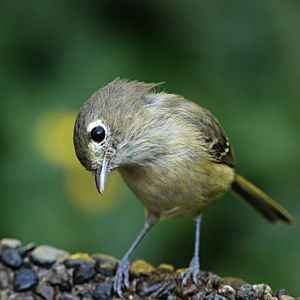Hutton's vireo facts for kids
Quick facts for kids Hutton's vireo |
|
|---|---|
 |
|
| Conservation status | |
| Scientific classification | |
| Genus: |
Vireo
|
| Species: |
huttoni
|
 |
|
The Hutton's vireo (Vireo huttoni) is a small songbird that lives in North and Central America. It's known for its quiet movements and its simple, repeated song. This bird is often hard to spot because its colors help it blend in with the trees.
Contents
What Does the Hutton's Vireo Look Like?
Hutton's vireos are about 5 inches (12–13 cm) long. They have dull olive-gray feathers on their backs and undersides. You might notice a faint white ring around their eyes and light white bars on their wings.
This bird looks a lot like a ruby-crowned kinglet. However, the Hutton's vireo has a slightly thicker beak and is a bit bigger. Its most common song sounds like "chu-wee" or "chew," repeated over and over. It also makes a call that sounds like a soft, mewing chatter.
Where Do Hutton's Vireos Live?
You can find Hutton's vireos from southern British Columbia in Canada all the way down to central Guatemala in Central America. They prefer forests that have a mix of deciduous trees (trees that lose their leaves) and other types of trees. They especially like live oak trees.
Scientists have studied the DNA of these birds. They think that the Hutton's vireos living near the Pacific coast might be different enough from those living inland to be considered a separate species!
What Do Hutton's Vireos Eat?
Hutton's vireos mostly eat insects. They find their food by gleaning. This means they carefully pick insects off leaves and branches as they move slowly through the tops of the trees.
Life Cycle and Habits
This vireo builds a special hanging cup-shaped nest. It hangs the nest from a fork in a tree branch. The female bird usually lays 3 to 4 eggs. These eggs are mostly white with a few scattered brown spots.
Most Hutton's vireos stay in the same area all year long. However, some might move short distances, especially to different elevations (higher or lower places) depending on the season. In winter, Hutton's vireos sometimes join a mixed-species flock. This is when different types of birds gather together to search for food.
How Did It Get Its Name?
The scientific name for this bird, Vireo huttoni, honors an American surveyor named William Rich Hutton. He was the person who first described this bird to science in 1851.
See also
 In Spanish: Vireo de Hutton para niños
In Spanish: Vireo de Hutton para niños


